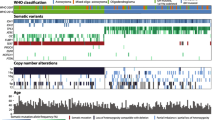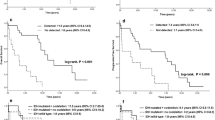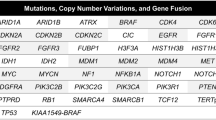Abstract
The phenotypic heterogeneity of low-grade gliomas (LGGs) is still inconsistently explained by known molecular abnormalities in patients treated according to the present standards of care. IDH1 codon 132 and IDH2 codon 172 sequencing was performed in a series of 47 LGGs and correlated with clinical presentation, MR imaging characteristics, genomic profile and outcome. A total of 38 IDH1 mutations at codon 132 and 2 IDH2 mutations at codon 172 were found, including 35 R132H (87.5%), 2 R132C (5.0%), 1 R132S (2.5%) and 2 R172 M (5%). The IDH mutations were significantly associated with 1p19q deleted genotype (P = 0.031) and p53 expression (P = 0.014). The presence (vs. absence) of IDH mutations was associated with a better outcome (5-year survival rate, 93% vs. 51%, respectively, P = 0.000001). After adjustment for age, tumor location and size, radiologic infiltration pattern and extent of surgery, multivariate analysis confirmed that IDH mutations was an independent favorable prognostic factor (hazard ratio = 40.9; 95% CI, 2.89–578.49, P = 0.006). Furthermore, we showed that patients with IDH-nonmutated tumors were significantly older (P = 0.020) and that these tumors involved significantly more frequently the insula (P = 0.004), were larger in size (>6 cm, P = 0.047), displayed an infiltrative pattern on MRI (P = 0.007) and were all p53 negative with no 1p19q deletion (P < 10−6). The absence of IDH mutations in LGGs identifies a novel entity of LGGs with distinctive location, infiltrative behavior, specific molecular alterations, and dismal outcome. These findings could significantly modify the LGG classification and may represent a new tool to guide patient-tailored therapy.


Similar content being viewed by others
References
Anker L, Ohgaki H, Ludeke BI, Herrmann HD, Kleihues P, Westphal M (1993) p53 protein accumulation and gene mutations in human glioma cell lines. Int J Cancer 55:982–987
Balss J, Meyer J, Mueller W, Korshunov A, Hartmann C, von Deimling A (2008) Analysis of the IDH1 codon 132 mutation in brain tumors. Acta Neuropathol 116:597–602
Bauman G, Fisher B, Watling C, Cairncross JG, Macdonald D (2009) Adult supratentorial low-grade glioma: long-term experience at a single institution. Int J Radiat Oncol Biol Phys 75:1401–1407
Bleeker FE, Lamba S, Leenstra S et al (2009) IDH1 mutations at residue p.R132 (IDH1(R132)) occur frequently in high-grade gliomas but not in other solid tumors. Hum Mutat 30:7–11
Bouvier C, Roll P, Quilichini B et al (2004) Deletions of chromosomes 1p and 19q are detectable on frozen smears of gliomas by FISH: usefulness for stereotactic biopsies. J Neurooncol 68:141–149
Brown R, Zlatescu M, Sijben A et al (2008) The use of magnetic resonance imaging to noninvasively detect genetic signatures in oligodendroglioma. Clin Cancer Res 14:2357–2362
Capper D, Zentgraf H, Balss J, Hartmann C, von Deimling A (2009) Monoclonal antibody specific for IDH1 R132H mutation. Acta Neuropathol 118:599–601
Chaichana KL, McGirt MJ, Laterra J, Olivi A, Quinones-Hinojosa A (2010) Recurrence and malignant degeneration after resection of adult hemispheric low-grade gliomas. J Neurosurg 112:10–17
Chaichana KL, McGirt MJ, Niranjan A, Olivi A, Burger PC, Quinones-Hinojosa A (2009) Prognostic significance of contrast-enhancing low-grade gliomas in adults and a review of the literature. Neurol Res 31:931–939
Chang EF, Clark A, Jensen RL et al (2009) Multiinstitutional validation of the University of California at San Francisco Low-Grade Glioma Prognostic Scoring System. Clinical article. J Neurosurg 111:203–210
Chang EF, Smith JS, Chang SM et al (2008) Preoperative prognostic classification system for hemispheric low-grade gliomas in adults. J Neurosurg 109:817–824
Coulibaly B, Nanni I, Quilichini B et al (2010) Epidermal growth factor receptor in glioblastomas: correlation between gene copy number and protein expression. Hum Pathol 41:815–823
Dhermain F, Saliou G, Parker F et al (2010) Microvascular leakage and contrast enhancement as prognostic factors for recurrence in unfavorable low-grade gliomas. J Neurooncol 97:81–88
Dubbink HJ, Taal W, van Marion R et al (2009) IDH1 mutations in low-grade astrocytomas predict survival but not response to temozolomide. Neurology 73:1792–1795
Fallon KB, Palmer CA, Roth KA et al (2004) Prognostic value of 1p, 19q, 9p, 10q, and EGFR-FISH analyses in recurrent oligodendrogliomas. J Neuropathol Exp Neurol 63:314–322
Felsberg J, Erkwoh A, Sabel MC et al (2004) Oligodendroglial tumors: refinement of candidate regions on chromosome arm 1p and correlation of 1p/19q status with survival. Brain Pathol 14:121–130
Figarella-Branger D, Colin C, Coulibaly B et al (2008) Histological and molecular classification of gliomas. Rev Neurol (Paris) 164:505–515
Goze C, Rigau V, Gibert L, Maudelonde T, Duffau H (2009) Lack of complete 1p19q deletion in a consecutive series of 12 WHO grade II gliomas involving the insula: a marker of worse prognosis? J Neurooncol 91:1–5
Hartmann C, Meyer J, Balss J et al (2009) Type and frequency of IDH1 and IDH2 mutations are related to astrocytic and oligodendroglial differentiation and age: a study of 1, 010 diffuse gliomas. Acta Neuropathol 118:469–474
Huang L, Jiang T, Yuan F, Li GL, Liu EZ, Wang ZC (2008) Correlations between molecular profile and tumor location in Chinese patients with oligodendroglial tumors. Clin Neurol Neurosurg 110:1020–1024
Ichimura K, Pearson DM, Kocialkowski S et al (2009) IDH1 mutations are present in the majority of common adult gliomas but rare in primary glioblastomas. Neuro Oncol 11:341–347
Iwamoto FM, Nicolardi L, Demopoulos A et al (2008) Clinical relevance of 1p and 19q deletion for patients with WHO grade 2 and 3 gliomas. J Neurooncol 88:293–298
Jenkinson MD, du Plessis DG, Smith TS, Joyce KA, Warnke PC, Walker C (2006) Histological growth patterns and genotype in oligodendroglial tumours: correlation with MRI features. Brain 129:1884–1891
Kapoor GS, Gocke TA, Chawla S et al (2009) Magnetic resonance perfusion-weighted imaging defines angiogenic subtypes of oligodendroglioma according to 1p19q and EGFR status. J Neurooncol 92:373–386
Koga H, Zhang S, Kumanishi T et al (1994) Analysis of p53 gene mutations in low- and high-grade astrocytomas by polymerase chain reaction-assisted single-strand conformation polymorphism and immunohistochemistry. Acta Neuropathol 87:225–232
Korshunov A, Golanov A, Sycheva R (2002) Immunohistochemical markers for prognosis of oligodendroglial neoplasms. J Neurooncol 58:237–253
Labussiere M, Idbaih A, Wang XW et al (2010) All the 1p19q codeleted gliomas are mutated on IDH1 or IDH2. Neurology 74:1886–1890
Laigle-Donadey F, Martin-Duverneuil N, Lejeune J et al (2004) Correlations between molecular profile and radiologic pattern in oligodendroglial tumors. Neurology 63:2360–2362
Law M, Young RJ, Babb JS et al (2008) Gliomas: predicting time to progression or survival with cerebral blood volume measurements at dynamic susceptibility-weighted contrast-enhanced perfusion MR imaging. Radiology 247:490–498
Louis DN, Ohgaki H, Wiestler OD et al (2007) The 2007 WHO classification of tumours of the central nervous system. Acta Neuropathol 114:97–109
Louis DN, von Deimling A, Chung RY et al (1993) Comparative study of p53 gene and protein alterations in human astrocytic tumors. J Neuropathol Exp Neurol 52:31–38
Mariani L, Deiana G, Vassella E et al (2006) Loss of heterozygosity 1p36 and 19q13 is a prognostic factor for overall survival in patients with diffuse WHO grade 2 gliomas treated without chemotherapy. J Clin Oncol 24:4758–4763
McGirt MJ, Chaichana KL, Attenello FJ et al (2008) Extent of surgical resection is independently associated with survival in patients with hemispheric infiltrating low-grade gliomas. Neurosurgery 63:700–707 (author reply 707–708)
Megyesi JF, Kachur E, Lee DH et al (2004) Imaging correlates of molecular signatures in oligodendrogliomas. Clin Cancer Res 10:4303–4306
Mueller W, Hartmann C, Hoffmann A et al (2002) Genetic signature of oligoastrocytomas correlates with tumor location and denotes distinct molecular subsets. Am J Pathol 161:313–319
Newcomb EW, Madonia WJ, Pisharody S, Lang FF, Koslow M, Miller DC (1993) A correlative study of p53 protein alteration and p53 gene mutation in glioblastoma multiforme. Brain Pathol 3:229–235
Ohgaki H, Kleihues P (2005) Population-based studies on incidence, survival rates, and genetic alterations in astrocytic and oligodendroglial gliomas. J Neuropathol Exp Neurol 64:479–489
Okamoto Y, Di Patre PL, Burkhard C et al (2004) Population-based study on incidence, survival rates, and genetic alterations of low-grade diffuse astrocytomas and oligodendrogliomas. Acta Neuropathol 108:49–56
Parsons DW, Jones S, Zhang X et al (2008) An integrated genomic analysis of human glioblastoma multiforme. Science 321:1807–1812
Peraud A, Kreth FW, Wiestler OD, Kleihues P, Reulen HJ (2002) Prognostic impact of TP53 mutations and P53 protein overexpression in supratentorial WHO grade II astrocytomas and oligoastrocytomas. Clin Cancer Res 8:1117–1124
Pignatti F, van den Bent M, Curran D et al (2002) Prognostic factors for survival in adult patients with cerebral low-grade glioma. J Clin Oncol 20:2076–2084
Riemenschneider MJ, Jeuken JW, Wesseling P, Reifenberger G (2010) Molecular diagnostics of gliomas: state of the art. Acta Neuropathol 120(5):567–584
Sanson M, Marie Y, Paris S et al (2009) Isocitrate dehydrogenase 1 codon 132 mutation is an important prognostic biomarker in gliomas. J Clin Oncol 27:4150–4154
Shaw EG, Berkey B, Coons SW et al (2008) Recurrence following neurosurgeon-determined gross-total resection of adult supratentorial low-grade glioma: results of a prospective clinical trial. J Neurosurg 109:835–841
Smith JS, Chang EF, Lamborn KR et al (2008) Role of extent of resection in the long-term outcome of low-grade hemispheric gliomas. J Clin Oncol 26:1338–1345
Smith JS, Tachibana I, Lee HK et al (2000) Mapping of the chromosome 19 q-arm glioma tumor suppressor gene using fluorescence in situ hybridization and novel microsatellite markers. Genes Chromosomes Cancer 29:16–25
Stander M, Peraud A, Leroch B, Kreth FW (2004) Prognostic impact of TP53 mutation status for adult patients with supratentorial World Health Organization Grade II astrocytoma or oligoastrocytoma: a long-term analysis. Cancer 101:1028–1035
Thiessen B, Maguire JA, McNeil K, Huntsman D, Martin MA, Horsman D (2003) Loss of heterozygosity for loci on chromosome arms 1p and 10q in oligodendroglial tumors: relationship to outcome and chemosensitivity. J Neurooncol 64:271–278
van den Bent MJ, Dubbink HJ, Marie Y et al (2010) IDH1 and IDH2 mutations are prognostic but not predictive for outcome in anaplastic oligodendroglial tumors: a report of the European Organization for Research and Treatment of Cancer Brain Tumor Group. Clin Cancer Res 16(5):1597–1604
van den Bent MJ, Looijenga LH, Langenberg K et al (2003) Chromosomal anomalies in oligodendroglial tumors are correlated with clinical features. Cancer 97:1276–1284
Watanabe T, Nobusawa S, Kleihues P, Ohgaki H (2009) IDH1 mutations are early events in the development of astrocytomas and oligodendrogliomas. Am J Pathol 174:1149–1153
Yan H, Parsons DW, Jin G et al (2009) IDH1 and IDH2 mutations in gliomas. N Engl J Med 360:765–773
Zlatescu MC, TehraniYazdi A, Sasaki H et al (2001) Tumor location and growth pattern correlate with genetic signature in oligodendroglial neoplasms. Cancer Res 61:6713–6715
Acknowledgments
We are grateful to Drs C. Bouvier, C. Fernandez, C. Courdy and A. Maues de Paula for their help in tumor handling and pathological diagnoses, to C. Boucard for managing clinical informations regarding the patients, to Dr S. Romain for frozen tissue management, to D. Intagliata, L. Scapuccini, F. Frassinetti, N. Baeza, S. Tong, A. Durand, S. Gilles, M. Molina and C. Schiano for technical assistance.
This work was supported by the Canceropole PACA institutional Grants, by INCa (Institut National du Cancer) grants RS019 and Gliother, by the GEFLUC (groupement des enterprises françaises dans la lutte contre le cancer) and by ARTC-Sud by (Association pour la Recherche sur les Tumeurs Cérébrales).
Author information
Authors and Affiliations
Corresponding author
Rights and permissions
About this article
Cite this article
Metellus, P., Coulibaly, B., Colin, C. et al. Absence of IDH mutation identifies a novel radiologic and molecular subtype of WHO grade II gliomas with dismal prognosis. Acta Neuropathol 120, 719–729 (2010). https://doi.org/10.1007/s00401-010-0777-8
Received:
Revised:
Accepted:
Published:
Issue Date:
DOI: https://doi.org/10.1007/s00401-010-0777-8




